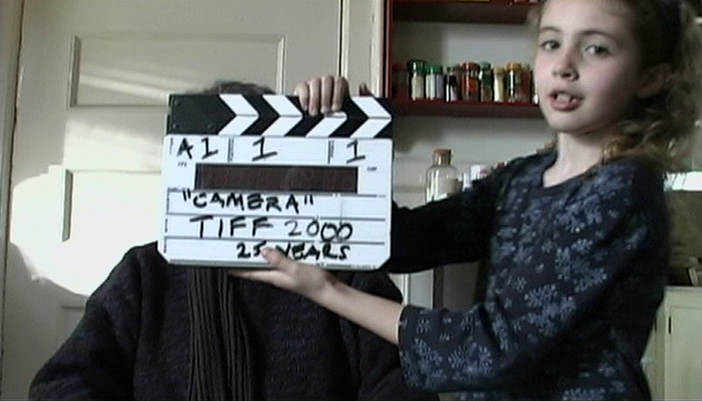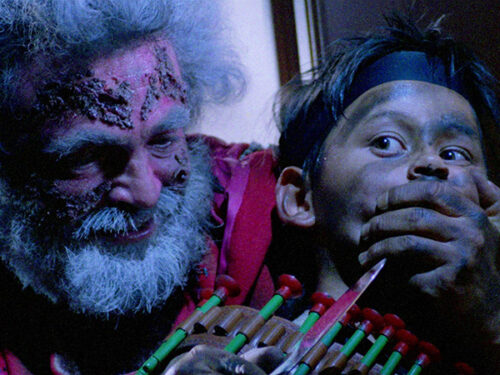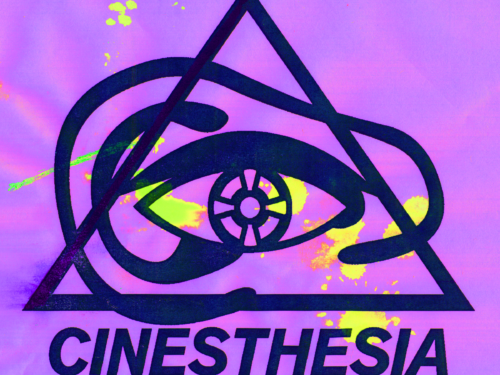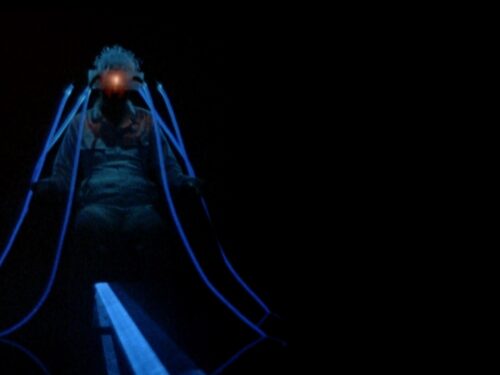Within a six-minute span, Cronenberg turns cinema itself into a virus that attacks us, controls us, and makes us over into something beautiful and diseased
At the turn of the millennium, the Toronto International Film Festival celebrated its 25th anniversary by commissioning a series of short films from notable Canadian directors such as Atom Egoyan, Guy Maddin, and, of course, David Cronenberg. I say of course because it is hard to think of a Canadian filmmaker as renowned, successful, and influential as Cronenberg. (Someone will doubtlessly mention James Cameron, but here there can be a valuable distinction between a “Canadian director” and a director who happens to be from Canada.)
It is also difficult to imagine any objections to Cronenberg being part of our October Horror series. Though his work has ranged across many genres, he is unquestionably a member in good standing of the horror canon. The entire sub-genre of “body horror,” while not necessarily invented by Cronenberg, is as synonymous with his name as the modern gangster film is with Scorsese’s, and now bears his inescapable presence as the Old Master to either embrace or reject. Shivers (1975), Rabid (1977), and The Brood (1979) stand as undeniable classics of low-budget horror; The Fly (1986) remains one of the high-water marks for Hollywood creature features; The Dead Zone (1983) stands atop the ever-growing heap of Stephen King adaptations as the most intelligent and assured of them all (officially certified as such years ago by our very own podcast, Cinesthesia — and all those achievements yet live in the shadows cast by the weird dread of Videodrome (1983), Dead Ringers (1988), and Crash (1996), all three among the best films ever made, of any genre. Cronenberg’s filmography offers a wealth of options for spooky season articles, big ripe gross fruits hanging low off a dead tree, easy to grab, rewarding to explore.
I am not here to talk about any of those films. I am here to talk about Camera (2000), the six-minute film that resulted from TIFF’s anniversary commission. Along with those films listed above, it is one of Cronenberg’s true masterpieces.
Tasked with exploring cinema itself as a theme, the movie features the great cult actor (and frequent Cronenberg collaborator) Les Carlson, playing an unnamed actor who delivers a monologue about a group of children finding an “old camera,” fixing it up, and making their own movie. In one of the film’s big jokes, the monologue is intercut with scenes of the children and the “old camera,” which is a large Panavision 35mm rig, with all the accompanying equipment one would find on the set of a moderately-budgeted professional production. As Carlson finishes his monologue, the children and the camera enter the room he is sitting in, and he becomes the actor in their version of the movie we have just finished watching.

The majority of the film is shot in turn-of-the-century digital video, the image noisy and in constant handheld motion. The final shot of Camera, however, is through the “eye” of the Panavision — classically lit, vibrantly colorful, sharp focus, the movement measured and controlled as it slowly tracks in for Carlson’s final close-up. It is the second big joke of the film, the two methods of image-making laid next to each other so as to make the differences as stark and striking as possible.
The metatextual cuteness would become smothering if it were not for the layers of haunting tones and dreadful thoughts woven into the film. The adorable prepubescent film crew is disarmingly charming, but also threateningly alien. For most of the film, the production circles Carlson like a school of sharks, before finally pressing in and getting him ready for a “take” — aptly named, as the film suggests that something must be taken from him in the process. He is made up, dressed, framed, and finally, absorbed. Here we see one of Cronenberg’s fascinations from at least as far back as Shivers: conflicts between two different ways of being, processed metaphorically as the horror of invasion and assimilation. As Cronenberg himself explains:
“A virus is only doing its job. It’s trying to live its life. The fact that it’s destroying you by doing so is not its fault. … I think most diseases would be very shocked to be considered diseases at all. It’s a very negative connotation. For them, it’s very positive when they take over your body and destroy you. It’s a triumph. … The characters in Shivers experience horror because they are still standard, straightforward members of the middle-class high-rise generation. … Of course they’re going to react with horror on a conscious level. They’re bound to resist. They’re going to be dragged kicking and screaming into this new experience. But, underneath, is something else…They look beautiful at the end. They don’t look diseased or awful.” — (Cronenberg on Cronenberg, Faber and Faber 1992)1
Unlike many horror filmmakers, Cronenberg never deals in the concept of “evil.” His threats are organic, evolutionary, acting in the way that makes the most sense from their biological or philosophical imperatives. The horror comes from the yawning chasm between the needs of the “people” and the needs of the “monster.” And given the prompt of the TIFF commission, here he has made cinema itself into the virus that attacks us, controls us, and makes us over into something beautiful and diseased.
At the end of Camera, the Panavision shot of Carlson is certainly beautiful, and yet there is an unmistakable feeling of sadness and loss. The Actor seems trapped by the intricate craft of the presentation. Maybe what we are seeing is the dismay of a human becoming art, transforming into a different order of being, which necessarily entails a loss of the former order. “Really, if you look at it in a cold light,” Carlson says in his monologue, “photography is death. It’s all about death. Memory, desire, aging, and death.” Later, he says, “When you record the moment, you record the death of the moment,” and then adds, ominously, “Children and death are a bad combination.”
In the final scene, though Carlson begins to repeat the same monologue he has delivered for the entire film, he only recites the first lines, and then stops. Narratively, we could say that this is Carlson altering his performance to suit the practical needs of the film production — only those lines are needed for this take, further lines will be filmed later, and assembled in editing. However, what Carlson does with his face in the very last moments of the image takes us beyond this narrative explanation. He sits, seemingly unable (whether for practical or emotional reasons) to speak any further words, and then, over a mere few seconds, in a quick series of facial expressions (that are performed so deeply as to appear involuntary) he reiterates and makes physical all of the anxieties and fears that for the past six minutes he had expressed through the intellectualized filter of language. And in that instant, the film runs out, and Carlson is swallowed in a flash of camera flare, followed by darkness.
As powerful and haunting as it is, that ending cannot fully overthrow the six minutes leading up to it. Some films are designed to be delivery systems of a particular moment, image, or idea. Camera is a film that lives in every part of itself, and the majority of its runtime is devoted to The Actor — to his story, to the contrast between him and the children, and to the antagonistic synergy between Carlson’s performance and André Pienaar’s camera, which bobs and weaves aggressively into the actor’s personal space, both amplifying and challenging Carlson’s interpretations of the written lines.2
There is no director I can think of from the anglophone cinema that can match Cronenberg’s commitment to decidedly un-detached irony. He is one of our most literary filmmakers, by which I mean his films give the impression of being written, and the cinematic elements of performance and presentation imply the kind of psychological interiority only accessible in prose. In Camera, this quality is emphasized by the dynamics between the digital camera and each of the film’s two subjects. When the kids and the film camera are on screen, they are muted and distant from us, emotionally opaque and inscrutable — the stark opposite of Carlson, for whom the digital camera shivers in sympathy with every beat of his performance.
Carlson shifts his emotional registers with precision and force, and the image relaxes and tightens, retreats and advances, sometimes in response and sometimes in anticipation. There are times when the image presents Carlson and his surroundings — a cozy, folksy kitchen — with a friendly warmth, as if sitting for morning coffee in a favorite uncle’s house. There are other times when the camera feels like, somehow at once, both an interrogator and conspirator, moving to extreme closeups with aggression and interest. When Carlson’s actor snarls that the Panavision’s age and clumsiness makes him “feel sad,” the image quivers with the same anger that bubbles up in his voice, and we have a short but potent exploration of the ways in which pity can give way to disgust. When the monologue turns towards acceptance – of the camera, of the children’s biological right to supersede their elders, of the inevitability of age, obsolescence, and death – the digital camera relaxes, retreats, and begins to make way for the children and their Panavision to take over.
Here is where I pause, and ask myself: could this little movie actually be doing all this? Could six minutes be enough to interweave this many layers of humor, horror, and humanity? It seems improbable, but the answer I return to again and again is yes. We do not live in a cultural context that allows, generally speaking, for short films to be considered among a filmmaker’s major works. Most exceptions are from within the proscribed world of the avant-garde, where shorter works, particularly those resonant with the traditions of abstract expressionist painting, are afforded the status of high art. In the world of narrative, both mainstream and independent, the short form is more likely to be seen as a curio or a lark — experimental juvenilia, promotional videos, commercials, gags, all lumped together in the “extras” section of a “real” (feature) film’s DVD release (precisely where Camera could most reliably be found, on the Criterion edition of Videodrome, in the days before ubiquitous online video platforms).
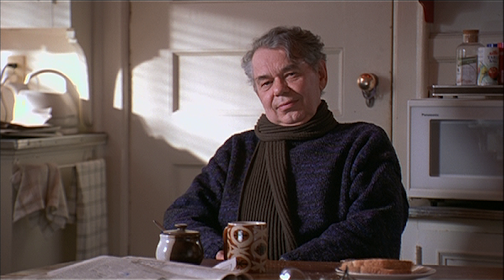
This state of affairs is not terribly unusual. For many decades, short stories and one act plays have been relegated to somewhat junior status beneath their longer relatives; in the world of music, individual songs might dominate the radio and dance floor, but albums have books written about them. Of course, all the real heads know that short works can be just as strong as longer ones, and that their compact nature can lead to higher degrees of focus and density, and thus to a different kind of power than what roomier forms can provide.
Even in its final moments, as it trots out a bespectacled child stand-in for Cronenberg as director of the movie-within-the-movie, Camera is at once comical and foreboding. The child crew moves in and quickly displaces intimacy with professionalism. The video surrenders to the film, the actor surrenders himself to the children. In the final shot, the actor appears both ridiculous and elegant. Cronenberg is not interested in resolving this tension. Any resolution that may come will be inevitable and evolutionary, and it will come for all of us, in our time. Our short, but potent, time.
Watch Camera on YouTube here
Find the complete October Horror 2023 series here:
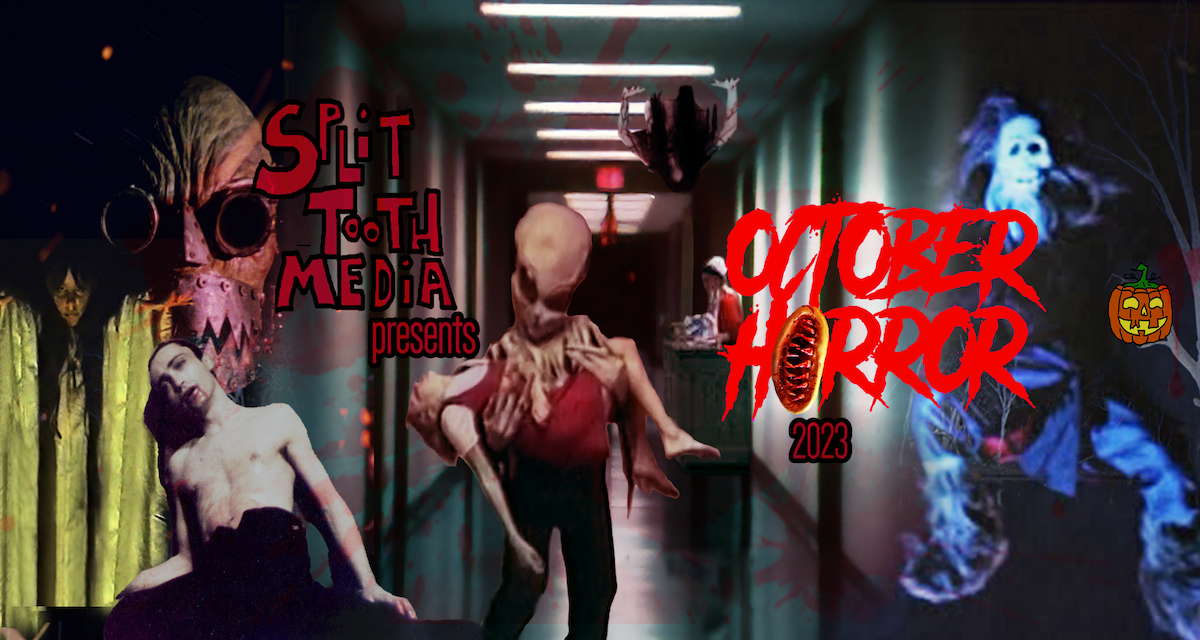
Stay up to date with all things Split Tooth Media
(Split Tooth may earn a commission from purchases made through affiliate links on our site.)
- Perhaps interesting to note that, in transcribing that passage, my word processor highlighted the word “shocked” in the second sentence, and suggested that I might instead change it to “shocking.” The grammar programmed into our machines can’t help but replicate our own biases, and revolt at the idea of conferring active subjecthood onto a virus. It feels very Cronenbergian to remark on this. One of the hallmarks of great art, and great artists, to me: once you let them into your mind, the world begins to reflect their insights back to you, long after you’ve put down the book or walked out of the cinema.
- It is curious that a film about the terrible power of photography would be so insistently reliant on a written text, and on a performance so reminiscent of the theater. It would be an appropriately Cronenbergian attitude to think of the dramatic-theatrical quality as a kind of antibody designed to thwart the viral invasion of cinema. At one point, Carlson relates a dream he had as a young man, in which he “caught” old age as if it were a disease, from a movie. Perhaps Cronenberg is concerned with preventing such transmission from his own work? To practice safe cinema, use stage drama techniques.

